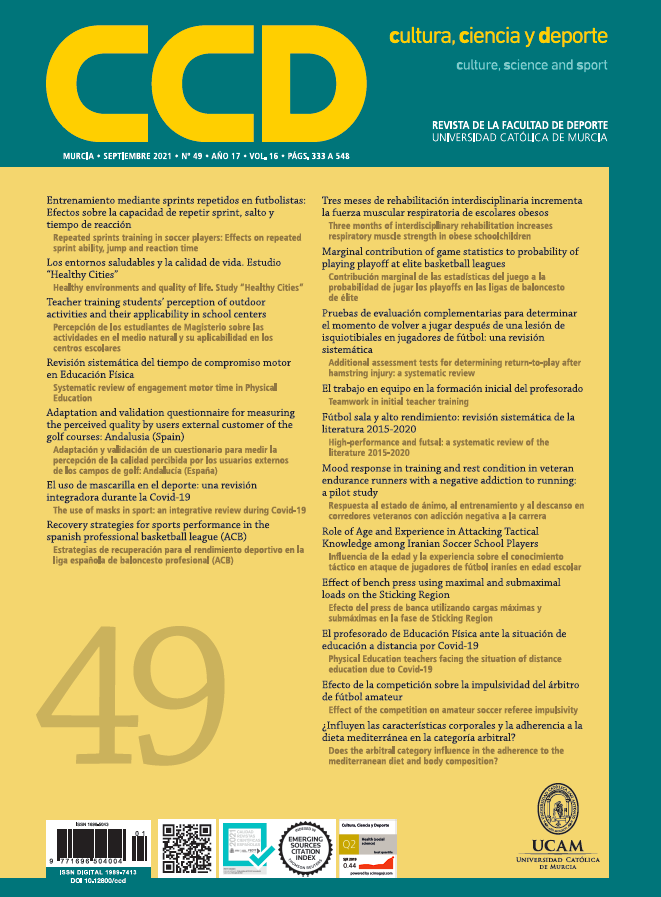Three months of interdisciplinary rehabilitation increases respiratory muscle strength in obese schoolchildren
DOI:
https://doi.org/10.12800/ccd.v16i49.1544Keywords:
Obesidad pediátrica, músculos respiratorios, rehabilitación, presiones respiratorias.Abstract
At present, there is no evidence regarding the effects of an interdisciplinary program, based on physical training, on respiratory muscle strength (FMR) in obese schoolchildren. The objective was to analyze the effects of a three-month interdisciplinary intervention program on fat mass (MA), muscle mass (MM) and FMR in schoolchildren with childhood obesity and without respiratory pathology. 11 schoolchildren, seven males and four female, participated during three months of the interdisciplinary program. Supervised by nutritionists, psychologists and trainers. FMR was evaluated with pimometry and body composition (CC) with anthropometry. There was a significant increase in FMR, expressed as maximum inspiratory pressure (PIM) (p = 0.029) and maximum expiratory pressure (PEM) (p = 0.006) in relation to their reference and absolute values. A significant decrease in the BMI score was found (p = 0.04), as well as associations between PIM (PIM / MA p = 0.005; r = -0.769) and PEM (PEM / MM p = 0.001; r = 0.835) with variables of CC. In conclusion, three months of interdisciplinary treatment of childhood obesity evoke increases in PIM and PEM, and these increases are associated with variations in CC.
References
Al-Khudairy, L., Loveman, E., Colquitt, J. L., Mead, E., Johnson, R. E., Fraser, H., … Rees, K. (2017). Diet, physical activity and behavioural interventions for the treatment of overweight or obese adolescents aged 12 to 17 years. Cochrane Database of Systematic Reviews, 2017(6). https://doi.org/10.1002/14651858.CD012691
American Thoracic Society/European Respiratory Society. (2002). ATS/ERS Statement on respiratory muscle testing. American Journal of Respiratory and Critical Care Medicine, 166(4), 518–624. https://doi.org/10.1164/rccm.166.4.518
Bahia, L., Schaan, C. W., Sparrenberger, K., Abreu, G. de A., Barufaldi, L. A., Coutinho, W., & Schaan, B. D. (2018). Overview of meta-analyses on prevention and treatment of childhood obesity. Jornal de Pediatria, 95(4), 385-400. https://doi.org/10.1016/j.jped.2018.07.009
Brashier, B., & Salvi, S. (2013). Obesity and Asthma: Physiological Perspective. Journal of Allergy, 2013, 1–11. https://doi.org/10.1155/2013/198068
Cohen, J. (1992). A Power Primer. Psychological Bulletin, 112(1), 155–159. https://doi.org/10.1016/j.jorganchem.2011.01.025
Contreras, I., Caussade, S., Sanchez, I., Montalvo, D., Pineda, N., Fierro, L., & Holmgren, N. (2007). Valores Espirométricos Normales En Niños Y Adolescentes Chilenos: Comparación Con Valores Extranjeros. Neumología Pediátrica, 8(153), 15–18. http://dx.doi.org/10.4067/S0034-98872015001100003
da Jung, R. G., & Schivinski, C. I. S. (2014). Avaliação da força muscular respiratória de crianças segundo a classificação do índice de massa corporal. Revista Paulista de Pediatria, 32(2), 250–255. https://doi.org/10.1590/0103-0582201432210313
Forno, E., Han, Y. Y., Mullen, J., & Celedón, J. C. (2018). Overweight, Obesity, and Lung Function in Children and Adults—A Meta-analysis. Journal of Allergy and Clinical Immunology: In Practice, 6(2), 570-581.e10. https://doi.org/10.1016/j.jaip.2017.07.010
Furman, E. G., Yarulina, A. M., & Sofronova, L. V. (2015). Lung Function and Respiratory Muscle Strength in Obese in Children. Pediatric Pharmacology, 12(2), 143. https://doi.org/10.15690/pf.v12i2/1276
García-Hermoso, A., Ramírez-Vélez, R., Ramírez-Campillo, R., Peterson, M. D., & Martínez-Vizcaíno, V. (2018). Concurrent aerobic plus resistance exercise versus aerobic exercise alone to improve health outcomes in paediatric obesity: a systematic review and meta-analysis. British Journal of Sports Medicine, 52(3), 161–166. https://doi.org/10.1136/bjsports-2016-096605
GBD 2015 Obesity Collaborators, Afshin, A., Forouzanfar, M. H., Reitsma, M. B., Sur, P., Estep, K., … Murray, C. J. L. (2017). Health Effects of Overweight and Obesity in 195 Countries over 25 Years. The New England Journal of Medicine, 377(1), 13–27. https://doi.org/10.1056/NEJMoa1614362
Karvonen, J., & Vuorimaa, T. (1988). Heart Rate and Exercise Intensity During Sports Activities Practical Application. Sports Medicine (Auckland, N.Z.), 312, 303–311.
Kerr, D. A. (1988). An anthropometric method for fractionation of skin, adipose, bone, muscle and residual tissue masses in males and females age 6 to 77 years (Doctoral dissertation, Theses (School of Kinesiology)/Simon Fraser University).
Kongkiattikul, L., Sritippayawan, S., & Chomtho, S. (2015). Relationship between Obesity Indices and Pulmonary Function Parameters in Obese Thai Children and Adolescents. The Indian Journal of Pediatrics, 82(12), 1112-1116. https://doi.org/10.1007/s12098-015-1777-4
Magnani, K. L., & Cataneo, A. J. M. (2007). Respiratory muscle strength in obese individuals and influence of upper-body fat distribution. Sao Paulo Medical Journal, 125(4), 215–219.
Marfell-Jones, M., Stewart, A., & Olds, T. (2006). Kinanthropometry IX: Proceedings of the 9th International Conference of the International Society for the Advancement of Kinanthropometry (Routledge., ed.).
Moreno, B. (2010). Estudio correlacional entre estadios de cambio para el ejercicio físico, motivación, intención de ser físicamente activo y fluidez disposicional en adolescentes extremenos [trabajo fin de Máster universitario en Investigación en Ciencias Sociales y Jurídicas con especialidad en Ciencias de la Actividad Física y el Deporte]. Trabajo Fin de Máster Universitario en Investigación en Ciencias Sociales y Jurídicas con especialidad en Ciencias de la Actividad Física y el Deporte. Universidad de Extremadura. Cáceres.
National Research Council. (2005). Food and Nutrition Board. Dietary reference intakes for energy, carbohydrate, fiber, fat, fatty acids, cholesterol, protein, and amino acids (macronutrients).
Navarro, X., Gatica, D., & Manterola, C. (2016). Effect of abdominal muscle training on respiratory muscle strength and forced expiratory flows in sedentary, healthy adolescents. Archivos Argentinos de Pediatria, 114(5), 434–440. https://doi.org/10.5546/aap.2016.eng.434
Nemet, D., Barkan, S., Epstein, Y., Friedland, O., Kowen, G., & Eliakim, A. (2005). Short- and Long-Term Beneficial Effects of a Combined Dietary-Behavioral-Physical Activity Intervention for the Treatment of Childhood Obesity. Pediatrics, 115(4), e443–e449. https://doi.org/10.1542/peds.2004-2172
Okubo, Y., Nochioka, K., & Testa, M. A. (2017). The impact of pediatric obesity on hospitalized children with lower respiratory tract infections in the United States. The clinical respiratory journal, 12(4), 1479-1484. https://doi.org/10.1111/crj.12694
Onis, M. De, Onyango, A. W., Borghi, E., Siyam, A., & Siekmann, J. (2007). Development of a WHO growth reference for school-aged children and adolescents. Bulletin of the World Health Organization, 043497(April), 660–667. https://doi.org/10.2471/BLT.
Parreira, V. F., Matos, C. M., Athayde, F. T., Moraes, K. S., Barbosa, M. H., & Britto, R. R. (2012). Evolution of respiratory muscle strength in post-operative gastroplasty. Brazilian Journal of Physical Therapy, 16(3), 225-230. http://dx.doi.org/10.1590/S1413-35552012000300008
Rodríguez-Valdés, S., Donoso-Riveros, D., Sánchez-Peña, E., Muñoz-Cofré, R., Conei, D., del-Sol, M., y Cabello, M.-E. (2019). Uso del Índice de Masa Corporal y Porcentaje de Grasa Corporal en el Análisis de la Función Pulmonar. International Journal of Morphology, 37(2), 592–599. https://doi.org/10.4067/s0717-95022019000200592
Scott, H. A., Wood, L. G., & Gibson, P. G. (2017). Role of Obesity in Asthma: Mechanisms and Management Strategies. Current Allergy and Asthma Reports, 17(8). https://doi.org/10.1007/s11882-017-0719-9
Sideleva, O., Black, K., & Dixon, A. E. (2013). Effects of obesity and weight loss on airway physiology and inflammation in asthma. Pulmonary Pharmacology and Therapeutics, 26(4), 455–458. https://doi.org/10.1016/j.pupt.2012.05.002
Sinha, I. P., Harwood, R., Semple, M. G., Hawcutt, D. B., Thursfield, R., Narayan, O., ... & Southern, K. W. (2020). COVID-19 infection in children. The Lancet Respiratory Medicine, 8(5), 446-447. https://doi.org/10.1056/NEJMc2005073
Strongoli, L. M., Gomez, C. L., & Coast, J. R. (2010). The effect of core exercises on transdiaphragmatic pressure. Journal of Sports Science and Medicine, 9(2), 270–274.
Thompson, W. W., Shay, D. K., Weintraub, E., Brammer, L., Cox, N., & Anderson, L. J. (2011). Mortality associated with influenza and respiratory syncytial virus in the United States. Medicine, 289(2), 179–186. doi:10.1001/jama.289.2.179
Travers, S. H., Jeffers, B. W., Bloch, C. A., Hill, J. O., & Eckel, R. H. (1995). Gender and Tanner stage differences in body composition and insulin sensitivity in early pubertal children. The Journal of Clinical Endocrinology & Metabolism, 80(1), 172-178.
Wadden, D., Allwood Newhook, L.-A., Twells, L., Farrell, J., & Gao, Z. (2018). Sex-Specific Association between Childhood BMI Trajectories and Asthma Phenotypes. International Journal of Pediatrics, 2018, 1–9. https://doi.org/10.1155/2018/9057435
Whitlock, E. P., O’Connor, E. A., Williams, S. B., Beil, T. L., & Lutz, K. W. (2010). Effectiveness of Weight Management Interventions in Children: A Targeted Systematic Review for the USPSTF. Pediatrics, 125(2), e396–e418. https://doi.org/10.1542/peds.2009-1955
Downloads
Published
How to Cite
Issue
Section
License
Copyright (c) 2021 Creative Commons Attribution License

This work is licensed under a Creative Commons Attribution-NonCommercial-ShareAlike 4.0 International License.
The authors who publish in this journal agree with the following terms:
- The authors retain the copyright and guarantee the journal the right to be the first publication of the work as well as licensed under a Creative Commons Attribution License that allows others to share the work with recognition of the authorship of the work and the initial publication in this journal.















